Leadership and Clinical Governance
VerifiedAdded on 2023/04/11
|10
|2173
|433
AI Summary
The evolution of a robust safety culture in healthcare requires responsible leadership from nurse managers to the frontline clinical nurses. This paper examines the impact of patient engagement towards promoting quality, effective and safe nursing care that is consistently patient-centered.
Contribute Materials
Your contribution can guide someone’s learning journey. Share your
documents today.

Running head: LEADERSHIP AND CLINICAL GOVERNANCE 1
Leadership and Clinical Governance
Name
Institution
Leadership and Clinical Governance
Name
Institution
Secure Best Marks with AI Grader
Need help grading? Try our AI Grader for instant feedback on your assignments.
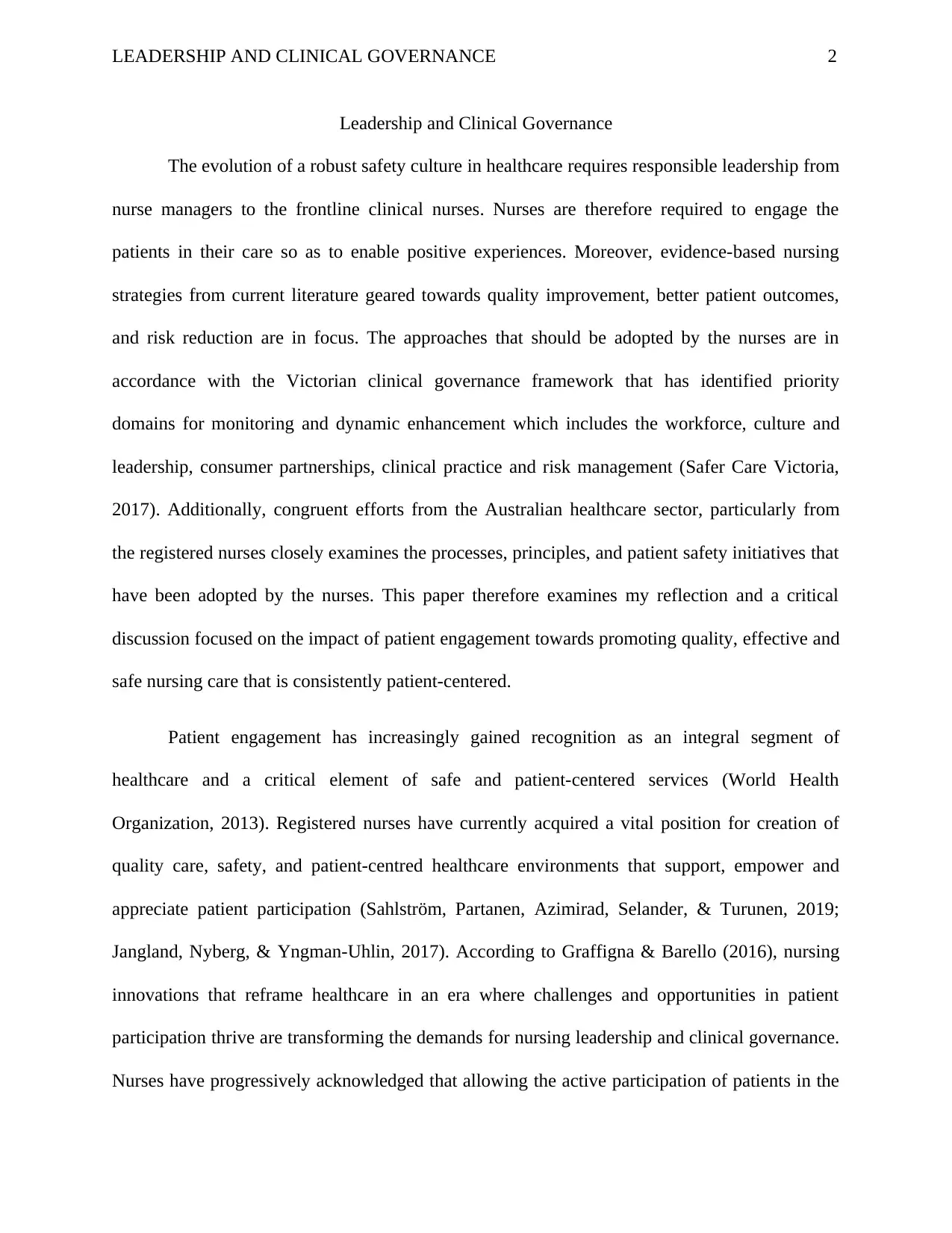
LEADERSHIP AND CLINICAL GOVERNANCE 2
Leadership and Clinical Governance
The evolution of a robust safety culture in healthcare requires responsible leadership from
nurse managers to the frontline clinical nurses. Nurses are therefore required to engage the
patients in their care so as to enable positive experiences. Moreover, evidence-based nursing
strategies from current literature geared towards quality improvement, better patient outcomes,
and risk reduction are in focus. The approaches that should be adopted by the nurses are in
accordance with the Victorian clinical governance framework that has identified priority
domains for monitoring and dynamic enhancement which includes the workforce, culture and
leadership, consumer partnerships, clinical practice and risk management (Safer Care Victoria,
2017). Additionally, congruent efforts from the Australian healthcare sector, particularly from
the registered nurses closely examines the processes, principles, and patient safety initiatives that
have been adopted by the nurses. This paper therefore examines my reflection and a critical
discussion focused on the impact of patient engagement towards promoting quality, effective and
safe nursing care that is consistently patient-centered.
Patient engagement has increasingly gained recognition as an integral segment of
healthcare and a critical element of safe and patient-centered services (World Health
Organization, 2013). Registered nurses have currently acquired a vital position for creation of
quality care, safety, and patient-centred healthcare environments that support, empower and
appreciate patient participation (Sahlström, Partanen, Azimirad, Selander, & Turunen, 2019;
Jangland, Nyberg, & Yngman-Uhlin, 2017). According to Graffigna & Barello (2016), nursing
innovations that reframe healthcare in an era where challenges and opportunities in patient
participation thrive are transforming the demands for nursing leadership and clinical governance.
Nurses have progressively acknowledged that allowing the active participation of patients in the
Leadership and Clinical Governance
The evolution of a robust safety culture in healthcare requires responsible leadership from
nurse managers to the frontline clinical nurses. Nurses are therefore required to engage the
patients in their care so as to enable positive experiences. Moreover, evidence-based nursing
strategies from current literature geared towards quality improvement, better patient outcomes,
and risk reduction are in focus. The approaches that should be adopted by the nurses are in
accordance with the Victorian clinical governance framework that has identified priority
domains for monitoring and dynamic enhancement which includes the workforce, culture and
leadership, consumer partnerships, clinical practice and risk management (Safer Care Victoria,
2017). Additionally, congruent efforts from the Australian healthcare sector, particularly from
the registered nurses closely examines the processes, principles, and patient safety initiatives that
have been adopted by the nurses. This paper therefore examines my reflection and a critical
discussion focused on the impact of patient engagement towards promoting quality, effective and
safe nursing care that is consistently patient-centered.
Patient engagement has increasingly gained recognition as an integral segment of
healthcare and a critical element of safe and patient-centered services (World Health
Organization, 2013). Registered nurses have currently acquired a vital position for creation of
quality care, safety, and patient-centred healthcare environments that support, empower and
appreciate patient participation (Sahlström, Partanen, Azimirad, Selander, & Turunen, 2019;
Jangland, Nyberg, & Yngman-Uhlin, 2017). According to Graffigna & Barello (2016), nursing
innovations that reframe healthcare in an era where challenges and opportunities in patient
participation thrive are transforming the demands for nursing leadership and clinical governance.
Nurses have progressively acknowledged that allowing the active participation of patients in the
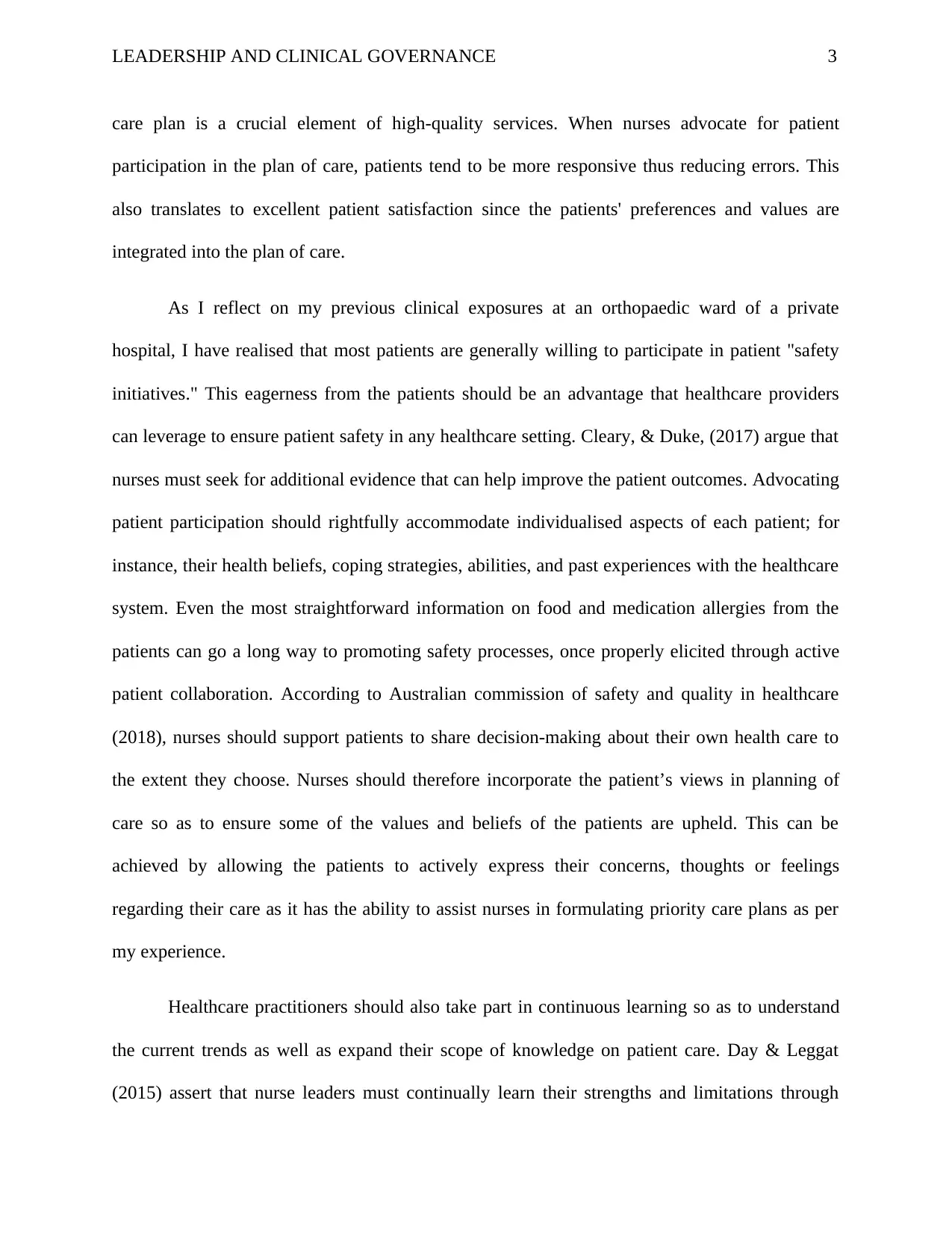
LEADERSHIP AND CLINICAL GOVERNANCE 3
care plan is a crucial element of high-quality services. When nurses advocate for patient
participation in the plan of care, patients tend to be more responsive thus reducing errors. This
also translates to excellent patient satisfaction since the patients' preferences and values are
integrated into the plan of care.
As I reflect on my previous clinical exposures at an orthopaedic ward of a private
hospital, I have realised that most patients are generally willing to participate in patient "safety
initiatives." This eagerness from the patients should be an advantage that healthcare providers
can leverage to ensure patient safety in any healthcare setting. Cleary, & Duke, (2017) argue that
nurses must seek for additional evidence that can help improve the patient outcomes. Advocating
patient participation should rightfully accommodate individualised aspects of each patient; for
instance, their health beliefs, coping strategies, abilities, and past experiences with the healthcare
system. Even the most straightforward information on food and medication allergies from the
patients can go a long way to promoting safety processes, once properly elicited through active
patient collaboration. According to Australian commission of safety and quality in healthcare
(2018), nurses should support patients to share decision-making about their own health care to
the extent they choose. Nurses should therefore incorporate the patient’s views in planning of
care so as to ensure some of the values and beliefs of the patients are upheld. This can be
achieved by allowing the patients to actively express their concerns, thoughts or feelings
regarding their care as it has the ability to assist nurses in formulating priority care plans as per
my experience.
Healthcare practitioners should also take part in continuous learning so as to understand
the current trends as well as expand their scope of knowledge on patient care. Day & Leggat
(2015) assert that nurse leaders must continually learn their strengths and limitations through
care plan is a crucial element of high-quality services. When nurses advocate for patient
participation in the plan of care, patients tend to be more responsive thus reducing errors. This
also translates to excellent patient satisfaction since the patients' preferences and values are
integrated into the plan of care.
As I reflect on my previous clinical exposures at an orthopaedic ward of a private
hospital, I have realised that most patients are generally willing to participate in patient "safety
initiatives." This eagerness from the patients should be an advantage that healthcare providers
can leverage to ensure patient safety in any healthcare setting. Cleary, & Duke, (2017) argue that
nurses must seek for additional evidence that can help improve the patient outcomes. Advocating
patient participation should rightfully accommodate individualised aspects of each patient; for
instance, their health beliefs, coping strategies, abilities, and past experiences with the healthcare
system. Even the most straightforward information on food and medication allergies from the
patients can go a long way to promoting safety processes, once properly elicited through active
patient collaboration. According to Australian commission of safety and quality in healthcare
(2018), nurses should support patients to share decision-making about their own health care to
the extent they choose. Nurses should therefore incorporate the patient’s views in planning of
care so as to ensure some of the values and beliefs of the patients are upheld. This can be
achieved by allowing the patients to actively express their concerns, thoughts or feelings
regarding their care as it has the ability to assist nurses in formulating priority care plans as per
my experience.
Healthcare practitioners should also take part in continuous learning so as to understand
the current trends as well as expand their scope of knowledge on patient care. Day & Leggat
(2015) assert that nurse leaders must continually learn their strengths and limitations through
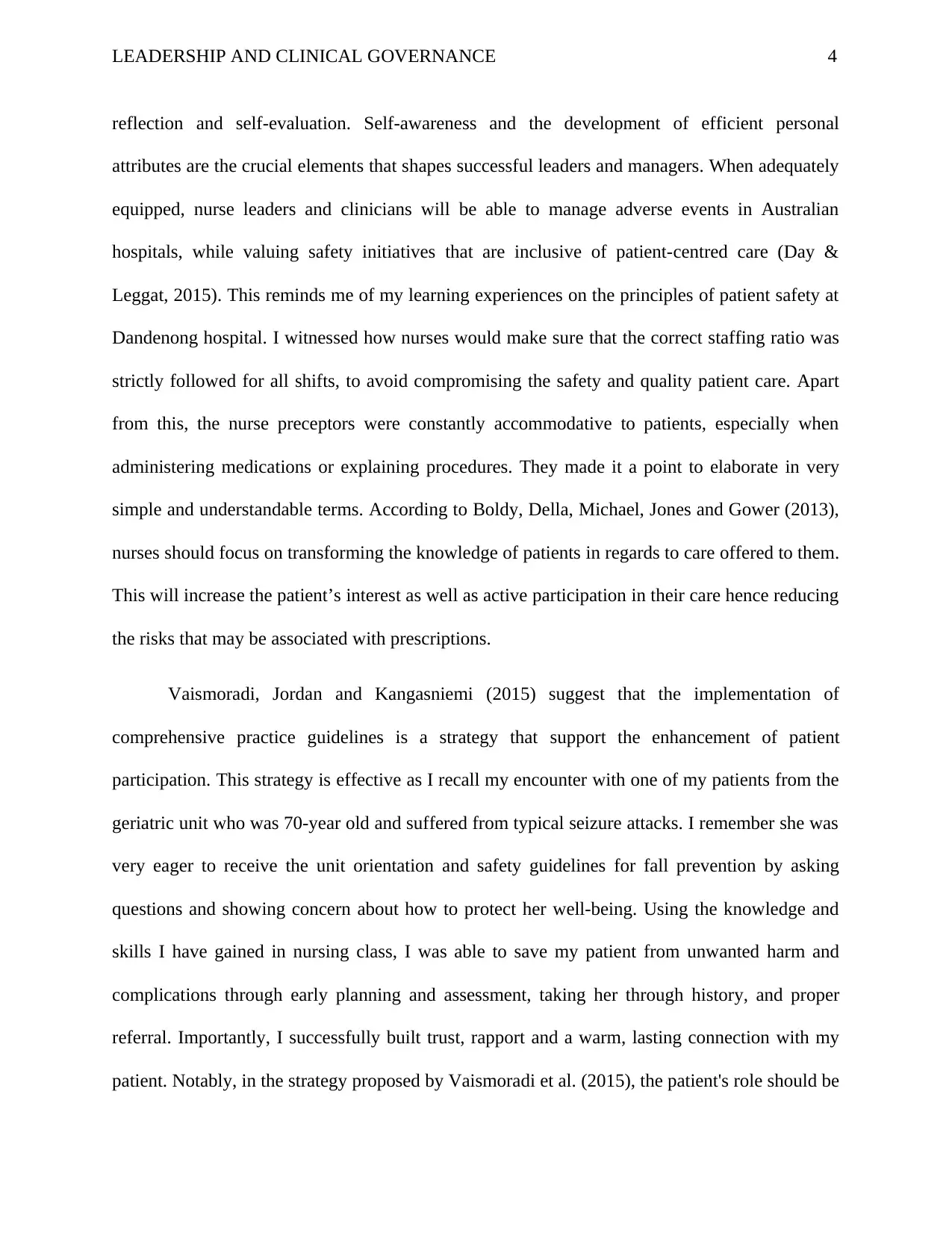
LEADERSHIP AND CLINICAL GOVERNANCE 4
reflection and self-evaluation. Self-awareness and the development of efficient personal
attributes are the crucial elements that shapes successful leaders and managers. When adequately
equipped, nurse leaders and clinicians will be able to manage adverse events in Australian
hospitals, while valuing safety initiatives that are inclusive of patient-centred care (Day &
Leggat, 2015). This reminds me of my learning experiences on the principles of patient safety at
Dandenong hospital. I witnessed how nurses would make sure that the correct staffing ratio was
strictly followed for all shifts, to avoid compromising the safety and quality patient care. Apart
from this, the nurse preceptors were constantly accommodative to patients, especially when
administering medications or explaining procedures. They made it a point to elaborate in very
simple and understandable terms. According to Boldy, Della, Michael, Jones and Gower (2013),
nurses should focus on transforming the knowledge of patients in regards to care offered to them.
This will increase the patient’s interest as well as active participation in their care hence reducing
the risks that may be associated with prescriptions.
Vaismoradi, Jordan and Kangasniemi (2015) suggest that the implementation of
comprehensive practice guidelines is a strategy that support the enhancement of patient
participation. This strategy is effective as I recall my encounter with one of my patients from the
geriatric unit who was 70-year old and suffered from typical seizure attacks. I remember she was
very eager to receive the unit orientation and safety guidelines for fall prevention by asking
questions and showing concern about how to protect her well-being. Using the knowledge and
skills I have gained in nursing class, I was able to save my patient from unwanted harm and
complications through early planning and assessment, taking her through history, and proper
referral. Importantly, I successfully built trust, rapport and a warm, lasting connection with my
patient. Notably, in the strategy proposed by Vaismoradi et al. (2015), the patient's role should be
reflection and self-evaluation. Self-awareness and the development of efficient personal
attributes are the crucial elements that shapes successful leaders and managers. When adequately
equipped, nurse leaders and clinicians will be able to manage adverse events in Australian
hospitals, while valuing safety initiatives that are inclusive of patient-centred care (Day &
Leggat, 2015). This reminds me of my learning experiences on the principles of patient safety at
Dandenong hospital. I witnessed how nurses would make sure that the correct staffing ratio was
strictly followed for all shifts, to avoid compromising the safety and quality patient care. Apart
from this, the nurse preceptors were constantly accommodative to patients, especially when
administering medications or explaining procedures. They made it a point to elaborate in very
simple and understandable terms. According to Boldy, Della, Michael, Jones and Gower (2013),
nurses should focus on transforming the knowledge of patients in regards to care offered to them.
This will increase the patient’s interest as well as active participation in their care hence reducing
the risks that may be associated with prescriptions.
Vaismoradi, Jordan and Kangasniemi (2015) suggest that the implementation of
comprehensive practice guidelines is a strategy that support the enhancement of patient
participation. This strategy is effective as I recall my encounter with one of my patients from the
geriatric unit who was 70-year old and suffered from typical seizure attacks. I remember she was
very eager to receive the unit orientation and safety guidelines for fall prevention by asking
questions and showing concern about how to protect her well-being. Using the knowledge and
skills I have gained in nursing class, I was able to save my patient from unwanted harm and
complications through early planning and assessment, taking her through history, and proper
referral. Importantly, I successfully built trust, rapport and a warm, lasting connection with my
patient. Notably, in the strategy proposed by Vaismoradi et al. (2015), the patient's role should be
Secure Best Marks with AI Grader
Need help grading? Try our AI Grader for instant feedback on your assignments.
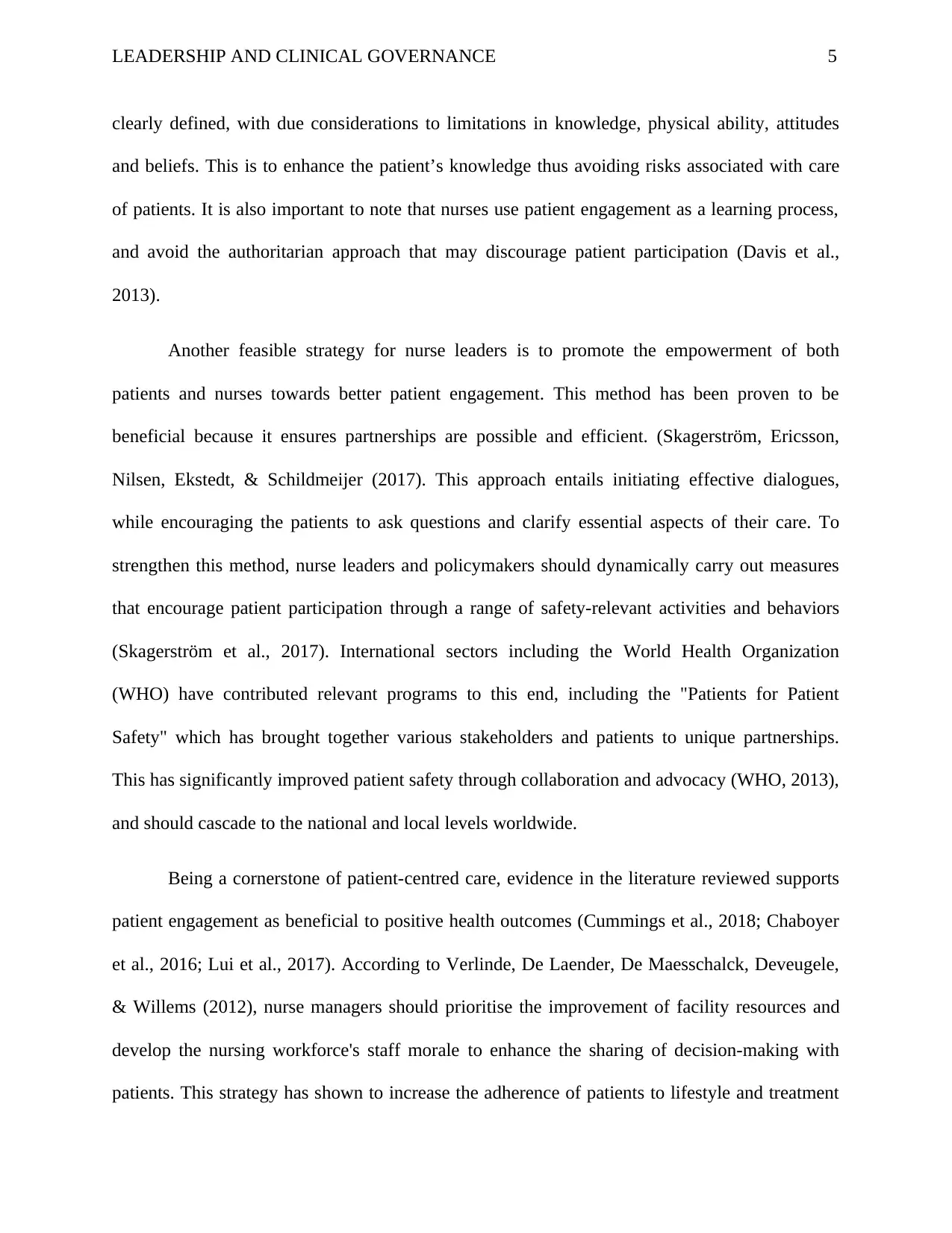
LEADERSHIP AND CLINICAL GOVERNANCE 5
clearly defined, with due considerations to limitations in knowledge, physical ability, attitudes
and beliefs. This is to enhance the patient’s knowledge thus avoiding risks associated with care
of patients. It is also important to note that nurses use patient engagement as a learning process,
and avoid the authoritarian approach that may discourage patient participation (Davis et al.,
2013).
Another feasible strategy for nurse leaders is to promote the empowerment of both
patients and nurses towards better patient engagement. This method has been proven to be
beneficial because it ensures partnerships are possible and efficient. (Skagerström, Ericsson,
Nilsen, Ekstedt, & Schildmeijer (2017). This approach entails initiating effective dialogues,
while encouraging the patients to ask questions and clarify essential aspects of their care. To
strengthen this method, nurse leaders and policymakers should dynamically carry out measures
that encourage patient participation through a range of safety-relevant activities and behaviors
(Skagerström et al., 2017). International sectors including the World Health Organization
(WHO) have contributed relevant programs to this end, including the "Patients for Patient
Safety" which has brought together various stakeholders and patients to unique partnerships.
This has significantly improved patient safety through collaboration and advocacy (WHO, 2013),
and should cascade to the national and local levels worldwide.
Being a cornerstone of patient-centred care, evidence in the literature reviewed supports
patient engagement as beneficial to positive health outcomes (Cummings et al., 2018; Chaboyer
et al., 2016; Lui et al., 2017). According to Verlinde, De Laender, De Maesschalck, Deveugele,
& Willems (2012), nurse managers should prioritise the improvement of facility resources and
develop the nursing workforce's staff morale to enhance the sharing of decision-making with
patients. This strategy has shown to increase the adherence of patients to lifestyle and treatment
clearly defined, with due considerations to limitations in knowledge, physical ability, attitudes
and beliefs. This is to enhance the patient’s knowledge thus avoiding risks associated with care
of patients. It is also important to note that nurses use patient engagement as a learning process,
and avoid the authoritarian approach that may discourage patient participation (Davis et al.,
2013).
Another feasible strategy for nurse leaders is to promote the empowerment of both
patients and nurses towards better patient engagement. This method has been proven to be
beneficial because it ensures partnerships are possible and efficient. (Skagerström, Ericsson,
Nilsen, Ekstedt, & Schildmeijer (2017). This approach entails initiating effective dialogues,
while encouraging the patients to ask questions and clarify essential aspects of their care. To
strengthen this method, nurse leaders and policymakers should dynamically carry out measures
that encourage patient participation through a range of safety-relevant activities and behaviors
(Skagerström et al., 2017). International sectors including the World Health Organization
(WHO) have contributed relevant programs to this end, including the "Patients for Patient
Safety" which has brought together various stakeholders and patients to unique partnerships.
This has significantly improved patient safety through collaboration and advocacy (WHO, 2013),
and should cascade to the national and local levels worldwide.
Being a cornerstone of patient-centred care, evidence in the literature reviewed supports
patient engagement as beneficial to positive health outcomes (Cummings et al., 2018; Chaboyer
et al., 2016; Lui et al., 2017). According to Verlinde, De Laender, De Maesschalck, Deveugele,
& Willems (2012), nurse managers should prioritise the improvement of facility resources and
develop the nursing workforce's staff morale to enhance the sharing of decision-making with
patients. This strategy has shown to increase the adherence of patients to lifestyle and treatment
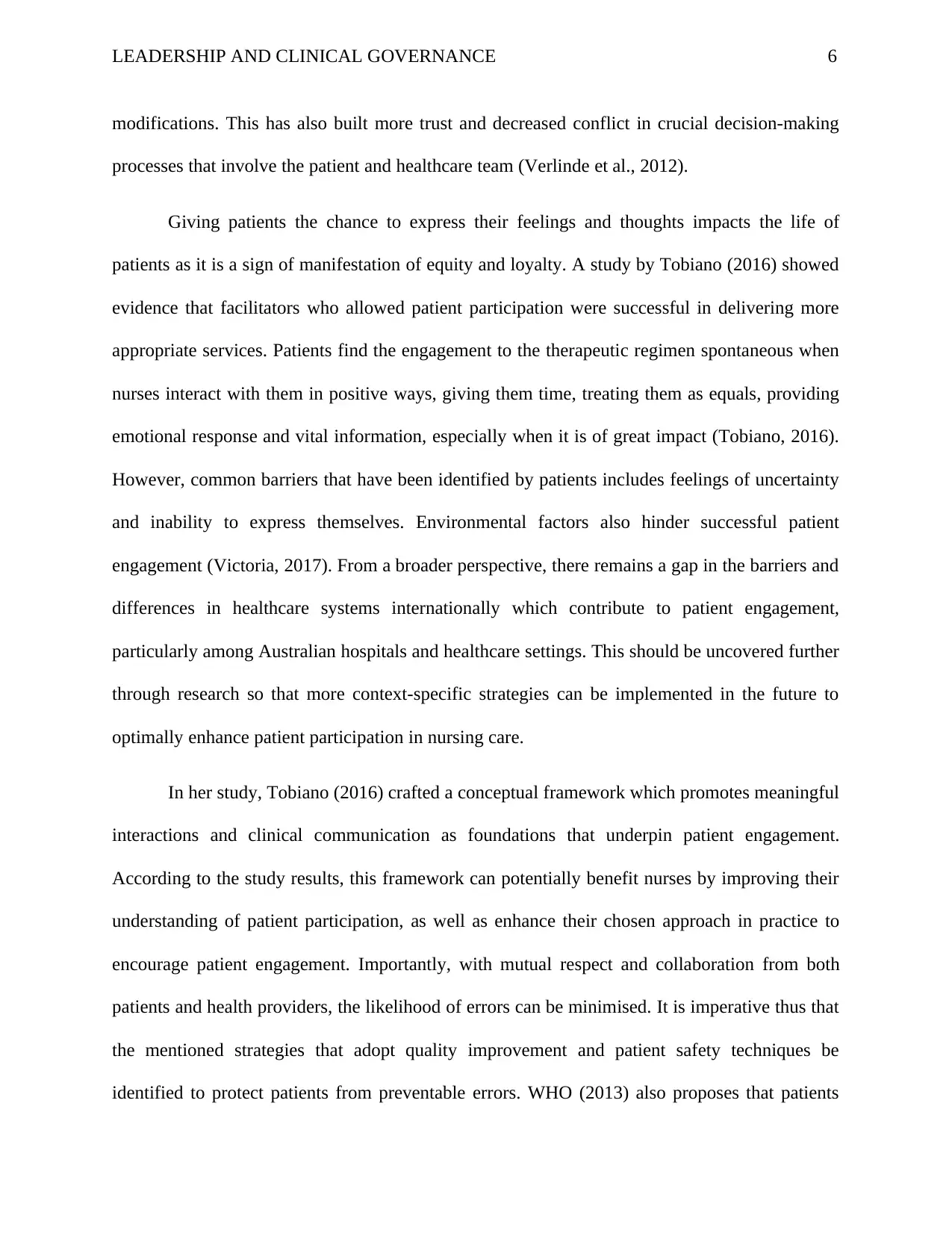
LEADERSHIP AND CLINICAL GOVERNANCE 6
modifications. This has also built more trust and decreased conflict in crucial decision-making
processes that involve the patient and healthcare team (Verlinde et al., 2012).
Giving patients the chance to express their feelings and thoughts impacts the life of
patients as it is a sign of manifestation of equity and loyalty. A study by Tobiano (2016) showed
evidence that facilitators who allowed patient participation were successful in delivering more
appropriate services. Patients find the engagement to the therapeutic regimen spontaneous when
nurses interact with them in positive ways, giving them time, treating them as equals, providing
emotional response and vital information, especially when it is of great impact (Tobiano, 2016).
However, common barriers that have been identified by patients includes feelings of uncertainty
and inability to express themselves. Environmental factors also hinder successful patient
engagement (Victoria, 2017). From a broader perspective, there remains a gap in the barriers and
differences in healthcare systems internationally which contribute to patient engagement,
particularly among Australian hospitals and healthcare settings. This should be uncovered further
through research so that more context-specific strategies can be implemented in the future to
optimally enhance patient participation in nursing care.
In her study, Tobiano (2016) crafted a conceptual framework which promotes meaningful
interactions and clinical communication as foundations that underpin patient engagement.
According to the study results, this framework can potentially benefit nurses by improving their
understanding of patient participation, as well as enhance their chosen approach in practice to
encourage patient engagement. Importantly, with mutual respect and collaboration from both
patients and health providers, the likelihood of errors can be minimised. It is imperative thus that
the mentioned strategies that adopt quality improvement and patient safety techniques be
identified to protect patients from preventable errors. WHO (2013) also proposes that patients
modifications. This has also built more trust and decreased conflict in crucial decision-making
processes that involve the patient and healthcare team (Verlinde et al., 2012).
Giving patients the chance to express their feelings and thoughts impacts the life of
patients as it is a sign of manifestation of equity and loyalty. A study by Tobiano (2016) showed
evidence that facilitators who allowed patient participation were successful in delivering more
appropriate services. Patients find the engagement to the therapeutic regimen spontaneous when
nurses interact with them in positive ways, giving them time, treating them as equals, providing
emotional response and vital information, especially when it is of great impact (Tobiano, 2016).
However, common barriers that have been identified by patients includes feelings of uncertainty
and inability to express themselves. Environmental factors also hinder successful patient
engagement (Victoria, 2017). From a broader perspective, there remains a gap in the barriers and
differences in healthcare systems internationally which contribute to patient engagement,
particularly among Australian hospitals and healthcare settings. This should be uncovered further
through research so that more context-specific strategies can be implemented in the future to
optimally enhance patient participation in nursing care.
In her study, Tobiano (2016) crafted a conceptual framework which promotes meaningful
interactions and clinical communication as foundations that underpin patient engagement.
According to the study results, this framework can potentially benefit nurses by improving their
understanding of patient participation, as well as enhance their chosen approach in practice to
encourage patient engagement. Importantly, with mutual respect and collaboration from both
patients and health providers, the likelihood of errors can be minimised. It is imperative thus that
the mentioned strategies that adopt quality improvement and patient safety techniques be
identified to protect patients from preventable errors. WHO (2013) also proposes that patients
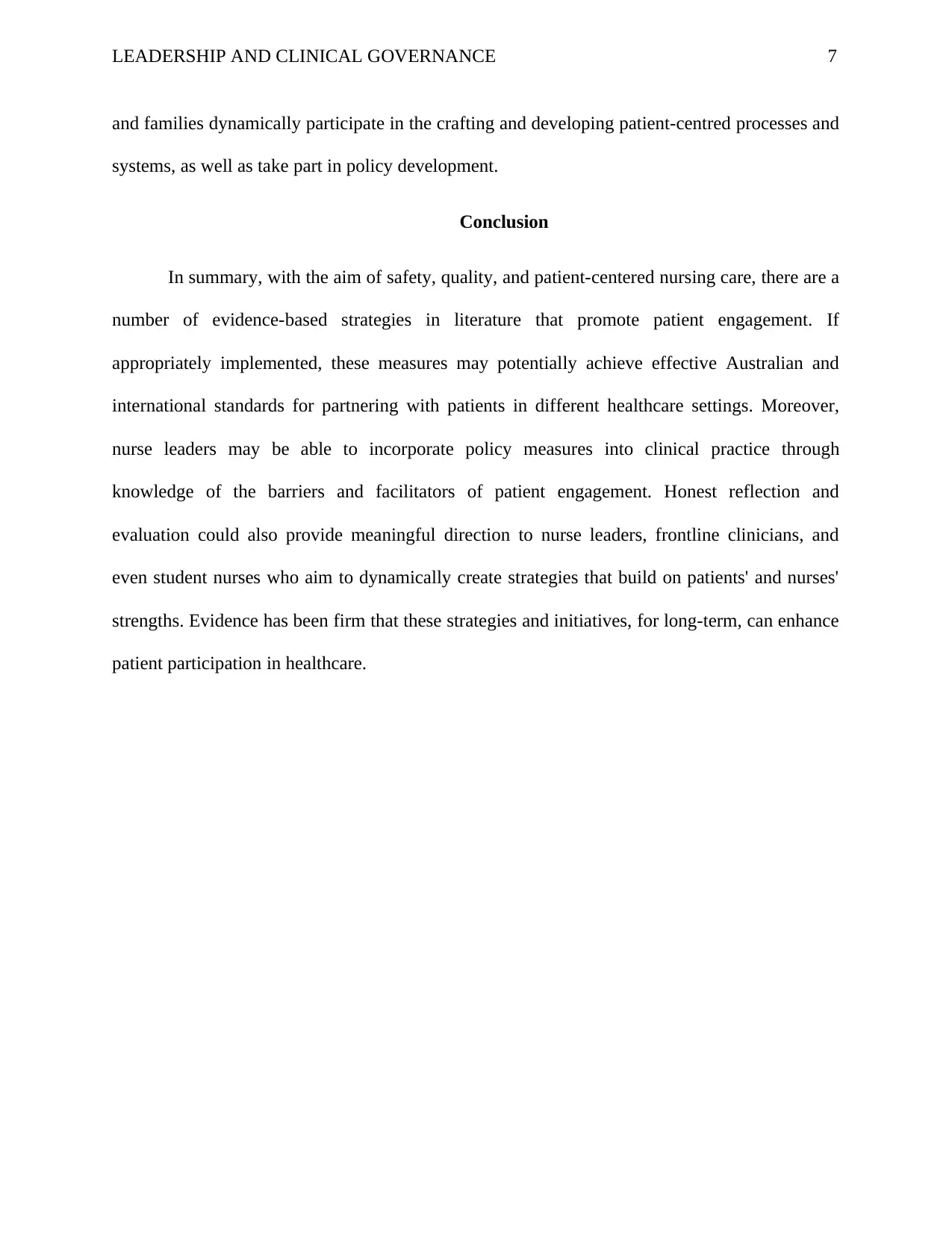
LEADERSHIP AND CLINICAL GOVERNANCE 7
and families dynamically participate in the crafting and developing patient-centred processes and
systems, as well as take part in policy development.
Conclusion
In summary, with the aim of safety, quality, and patient-centered nursing care, there are a
number of evidence-based strategies in literature that promote patient engagement. If
appropriately implemented, these measures may potentially achieve effective Australian and
international standards for partnering with patients in different healthcare settings. Moreover,
nurse leaders may be able to incorporate policy measures into clinical practice through
knowledge of the barriers and facilitators of patient engagement. Honest reflection and
evaluation could also provide meaningful direction to nurse leaders, frontline clinicians, and
even student nurses who aim to dynamically create strategies that build on patients' and nurses'
strengths. Evidence has been firm that these strategies and initiatives, for long-term, can enhance
patient participation in healthcare.
and families dynamically participate in the crafting and developing patient-centred processes and
systems, as well as take part in policy development.
Conclusion
In summary, with the aim of safety, quality, and patient-centered nursing care, there are a
number of evidence-based strategies in literature that promote patient engagement. If
appropriately implemented, these measures may potentially achieve effective Australian and
international standards for partnering with patients in different healthcare settings. Moreover,
nurse leaders may be able to incorporate policy measures into clinical practice through
knowledge of the barriers and facilitators of patient engagement. Honest reflection and
evaluation could also provide meaningful direction to nurse leaders, frontline clinicians, and
even student nurses who aim to dynamically create strategies that build on patients' and nurses'
strengths. Evidence has been firm that these strategies and initiatives, for long-term, can enhance
patient participation in healthcare.
Paraphrase This Document
Need a fresh take? Get an instant paraphrase of this document with our AI Paraphraser
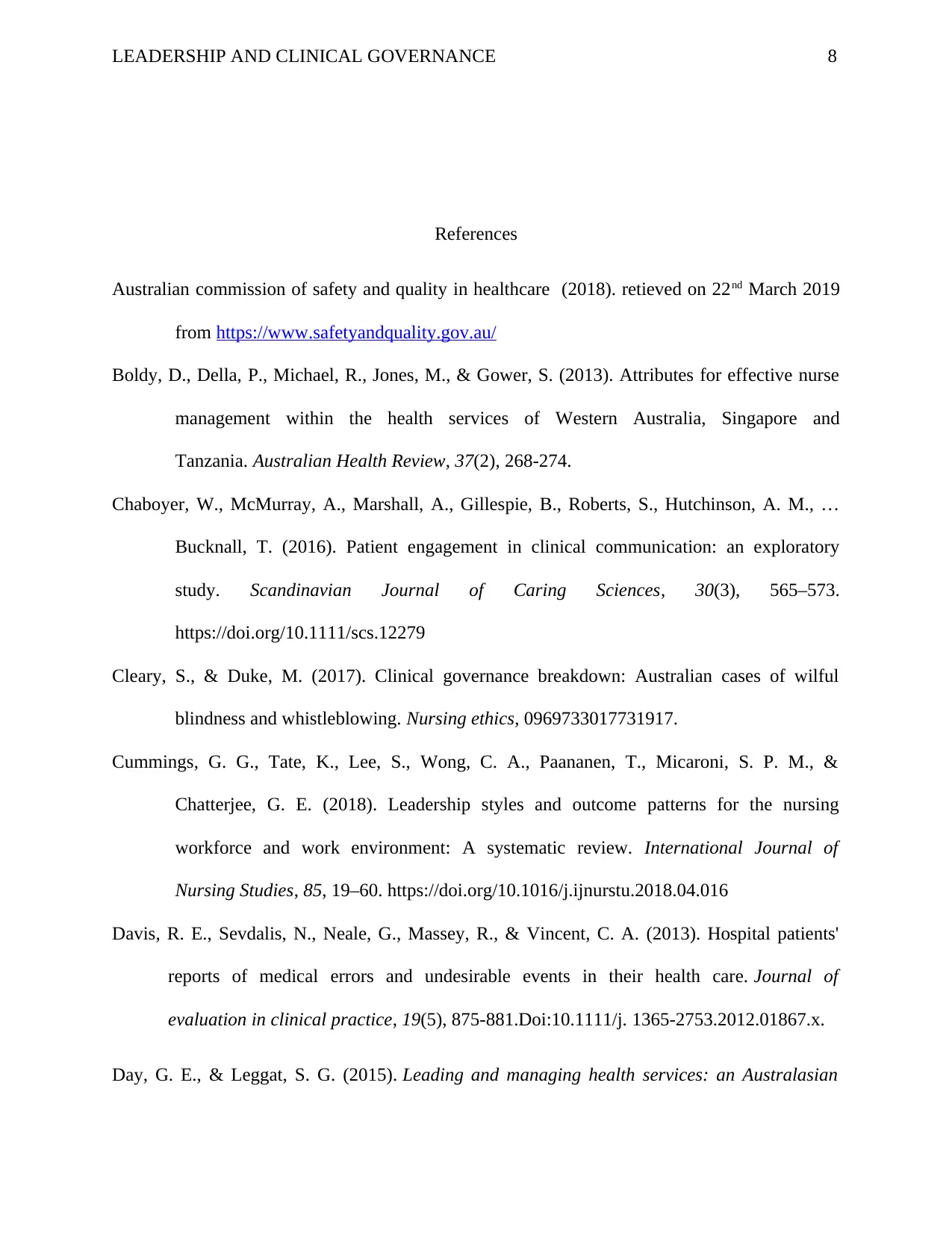
LEADERSHIP AND CLINICAL GOVERNANCE 8
References
Australian commission of safety and quality in healthcare (2018). retieved on 22nd March 2019
from https://www.safetyandquality.gov.au/
Boldy, D., Della, P., Michael, R., Jones, M., & Gower, S. (2013). Attributes for effective nurse
management within the health services of Western Australia, Singapore and
Tanzania. Australian Health Review, 37(2), 268-274.
Chaboyer, W., McMurray, A., Marshall, A., Gillespie, B., Roberts, S., Hutchinson, A. M., …
Bucknall, T. (2016). Patient engagement in clinical communication: an exploratory
study. Scandinavian Journal of Caring Sciences, 30(3), 565–573.
https://doi.org/10.1111/scs.12279
Cleary, S., & Duke, M. (2017). Clinical governance breakdown: Australian cases of wilful
blindness and whistleblowing. Nursing ethics, 0969733017731917.
Cummings, G. G., Tate, K., Lee, S., Wong, C. A., Paananen, T., Micaroni, S. P. M., &
Chatterjee, G. E. (2018). Leadership styles and outcome patterns for the nursing
workforce and work environment: A systematic review. International Journal of
Nursing Studies, 85, 19–60. https://doi.org/10.1016/j.ijnurstu.2018.04.016
Davis, R. E., Sevdalis, N., Neale, G., Massey, R., & Vincent, C. A. (2013). Hospital patients'
reports of medical errors and undesirable events in their health care. Journal of
evaluation in clinical practice, 19(5), 875-881.Doi:10.1111/j. 1365-2753.2012.01867.x.
Day, G. E., & Leggat, S. G. (2015). Leading and managing health services: an Australasian
References
Australian commission of safety and quality in healthcare (2018). retieved on 22nd March 2019
from https://www.safetyandquality.gov.au/
Boldy, D., Della, P., Michael, R., Jones, M., & Gower, S. (2013). Attributes for effective nurse
management within the health services of Western Australia, Singapore and
Tanzania. Australian Health Review, 37(2), 268-274.
Chaboyer, W., McMurray, A., Marshall, A., Gillespie, B., Roberts, S., Hutchinson, A. M., …
Bucknall, T. (2016). Patient engagement in clinical communication: an exploratory
study. Scandinavian Journal of Caring Sciences, 30(3), 565–573.
https://doi.org/10.1111/scs.12279
Cleary, S., & Duke, M. (2017). Clinical governance breakdown: Australian cases of wilful
blindness and whistleblowing. Nursing ethics, 0969733017731917.
Cummings, G. G., Tate, K., Lee, S., Wong, C. A., Paananen, T., Micaroni, S. P. M., &
Chatterjee, G. E. (2018). Leadership styles and outcome patterns for the nursing
workforce and work environment: A systematic review. International Journal of
Nursing Studies, 85, 19–60. https://doi.org/10.1016/j.ijnurstu.2018.04.016
Davis, R. E., Sevdalis, N., Neale, G., Massey, R., & Vincent, C. A. (2013). Hospital patients'
reports of medical errors and undesirable events in their health care. Journal of
evaluation in clinical practice, 19(5), 875-881.Doi:10.1111/j. 1365-2753.2012.01867.x.
Day, G. E., & Leggat, S. G. (2015). Leading and managing health services: an Australasian

LEADERSHIP AND CLINICAL GOVERNANCE 9
perspective. Cambridge University Press. Retrieved from
https://books.google.com/books?hl=en&lr=&id=C74sCQAAQBAJ&pgis=1
Graffigna, G., & Barello, S. (2015). Innovating healthcare in the era of patient engagement:
Challenges, opportunities & new trends. In Patient Engagement (pp. 1-12). Sciendo
Migration. https://doi.org/10.1515/9783110452440-002
Health Workforce Australia (2013). Health LEADS Australia: The Australian health leadership
framework. Retrieved from http://www.hwa.gov.au/sites/uploads/Health -LEADS-
Australia-A4-FINAL.pdf
Jangland, E., Nyberg, B., & Yngman-Uhlin, P. (2017). 'It's a matter of patient safety':
understanding challenges in everyday clinical practice for achieving good care on the
surgical ward - a qualitative study. Scandinavian Journal of Caring Sciences. 2017 June;
31(2):323-331. doi: 10.1111/scs.12350. Epub 2016 Jul 21.
Wong, E. L., Lui, S., Cheung, A. W., Yam, C. H., Huang, N. F., Tam, W. W., & Yeoh, E.
(2017). Views and Experience on Patient Engagement in Healthcare Professionals and
Patients—How Are They Different?. Open Journal of Nursing, 7(06), 615.
https://doi.org/10.4236/ojn.2017.76046
Safer Care Victoria (2017). Healthcare Victorian clinical governance framework, (June 2017).
Sahlström, M., Partanen, P., Azimirad, M., Selander, T., & Turunen, H. (2019). Patient
participation in patient safety-An exploration of promoting factors. Journal of
Nursing Management, 27(1), 84–92. https://doi.org/10.1111/jonm.12651
Skagerström, J., Ericsson, C., Nilsen, P., Ekstedt, M., & Schildmeijer, K. (2017). Patient
perspective. Cambridge University Press. Retrieved from
https://books.google.com/books?hl=en&lr=&id=C74sCQAAQBAJ&pgis=1
Graffigna, G., & Barello, S. (2015). Innovating healthcare in the era of patient engagement:
Challenges, opportunities & new trends. In Patient Engagement (pp. 1-12). Sciendo
Migration. https://doi.org/10.1515/9783110452440-002
Health Workforce Australia (2013). Health LEADS Australia: The Australian health leadership
framework. Retrieved from http://www.hwa.gov.au/sites/uploads/Health -LEADS-
Australia-A4-FINAL.pdf
Jangland, E., Nyberg, B., & Yngman-Uhlin, P. (2017). 'It's a matter of patient safety':
understanding challenges in everyday clinical practice for achieving good care on the
surgical ward - a qualitative study. Scandinavian Journal of Caring Sciences. 2017 June;
31(2):323-331. doi: 10.1111/scs.12350. Epub 2016 Jul 21.
Wong, E. L., Lui, S., Cheung, A. W., Yam, C. H., Huang, N. F., Tam, W. W., & Yeoh, E.
(2017). Views and Experience on Patient Engagement in Healthcare Professionals and
Patients—How Are They Different?. Open Journal of Nursing, 7(06), 615.
https://doi.org/10.4236/ojn.2017.76046
Safer Care Victoria (2017). Healthcare Victorian clinical governance framework, (June 2017).
Sahlström, M., Partanen, P., Azimirad, M., Selander, T., & Turunen, H. (2019). Patient
participation in patient safety-An exploration of promoting factors. Journal of
Nursing Management, 27(1), 84–92. https://doi.org/10.1111/jonm.12651
Skagerström, J., Ericsson, C., Nilsen, P., Ekstedt, M., & Schildmeijer, K. (2017). Patient
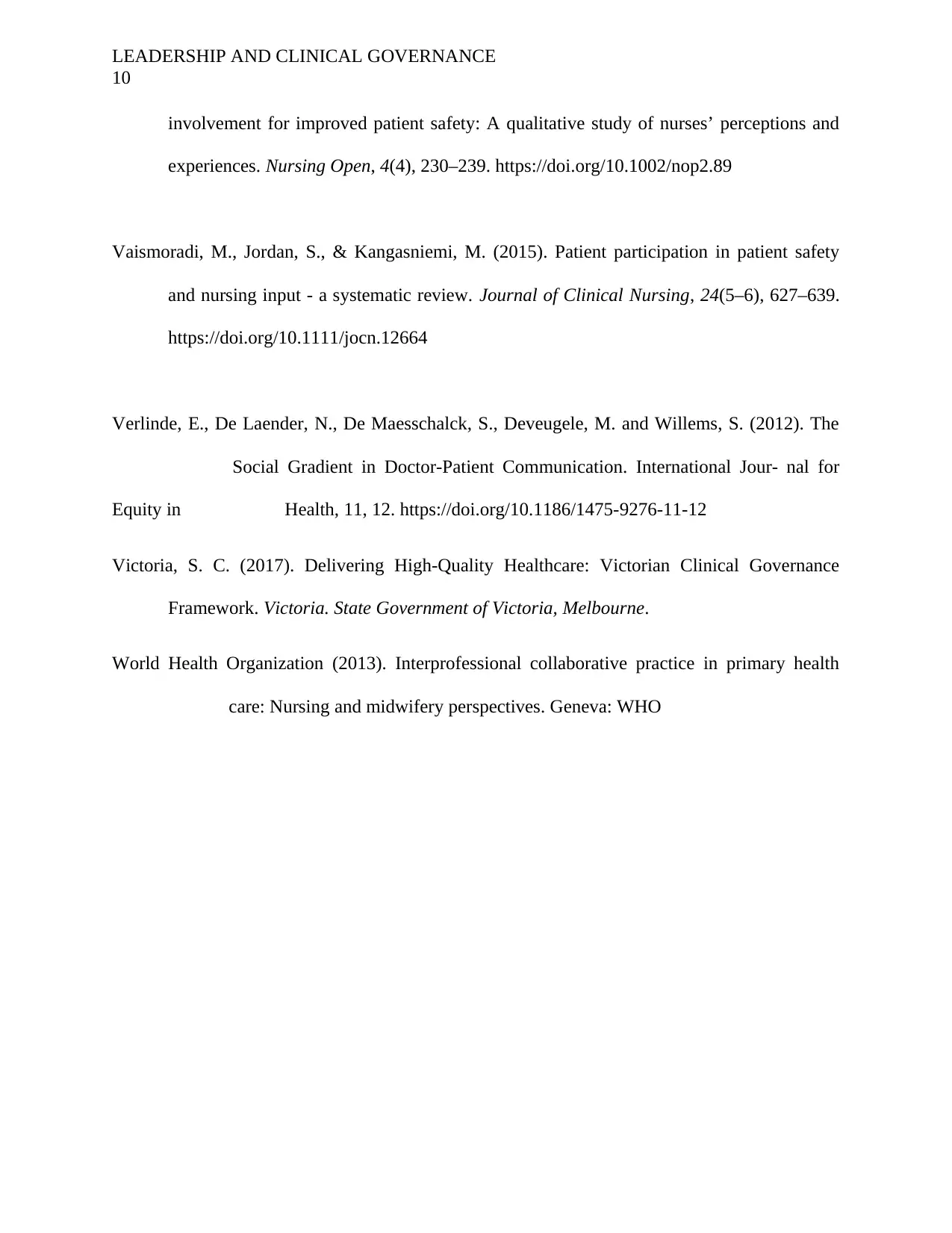
LEADERSHIP AND CLINICAL GOVERNANCE
10
involvement for improved patient safety: A qualitative study of nurses’ perceptions and
experiences. Nursing Open, 4(4), 230–239. https://doi.org/10.1002/nop2.89
Vaismoradi, M., Jordan, S., & Kangasniemi, M. (2015). Patient participation in patient safety
and nursing input - a systematic review. Journal of Clinical Nursing, 24(5–6), 627–639.
https://doi.org/10.1111/jocn.12664
Verlinde, E., De Laender, N., De Maesschalck, S., Deveugele, M. and Willems, S. (2012). The
Social Gradient in Doctor-Patient Communication. International Jour- nal for
Equity in Health, 11, 12. https://doi.org/10.1186/1475-9276-11-12
Victoria, S. C. (2017). Delivering High-Quality Healthcare: Victorian Clinical Governance
Framework. Victoria. State Government of Victoria, Melbourne.
World Health Organization (2013). Interprofessional collaborative practice in primary health
care: Nursing and midwifery perspectives. Geneva: WHO
10
involvement for improved patient safety: A qualitative study of nurses’ perceptions and
experiences. Nursing Open, 4(4), 230–239. https://doi.org/10.1002/nop2.89
Vaismoradi, M., Jordan, S., & Kangasniemi, M. (2015). Patient participation in patient safety
and nursing input - a systematic review. Journal of Clinical Nursing, 24(5–6), 627–639.
https://doi.org/10.1111/jocn.12664
Verlinde, E., De Laender, N., De Maesschalck, S., Deveugele, M. and Willems, S. (2012). The
Social Gradient in Doctor-Patient Communication. International Jour- nal for
Equity in Health, 11, 12. https://doi.org/10.1186/1475-9276-11-12
Victoria, S. C. (2017). Delivering High-Quality Healthcare: Victorian Clinical Governance
Framework. Victoria. State Government of Victoria, Melbourne.
World Health Organization (2013). Interprofessional collaborative practice in primary health
care: Nursing and midwifery perspectives. Geneva: WHO
1 out of 10
Related Documents
Your All-in-One AI-Powered Toolkit for Academic Success.
+13062052269
info@desklib.com
Available 24*7 on WhatsApp / Email
![[object Object]](/_next/static/media/star-bottom.7253800d.svg)
Unlock your academic potential
© 2024 | Zucol Services PVT LTD | All rights reserved.





